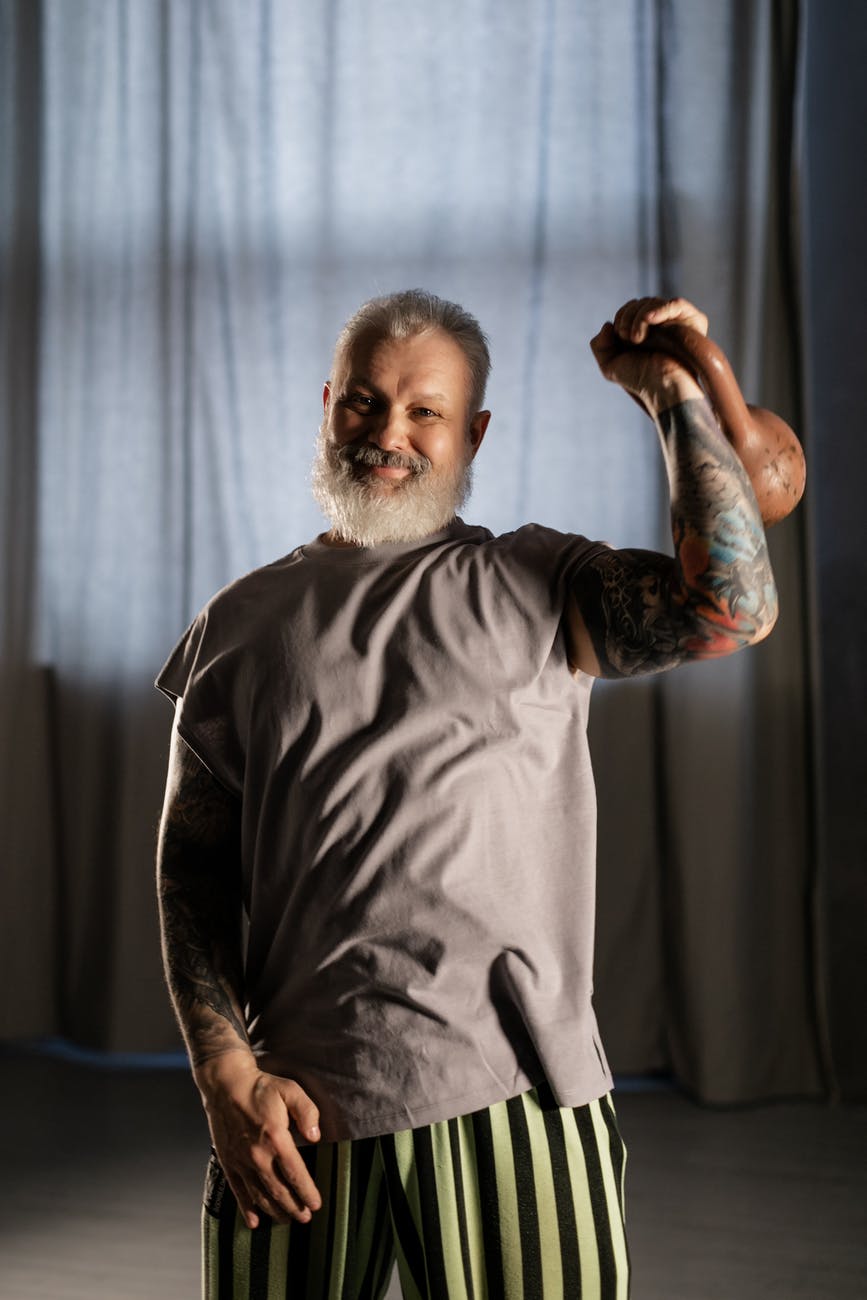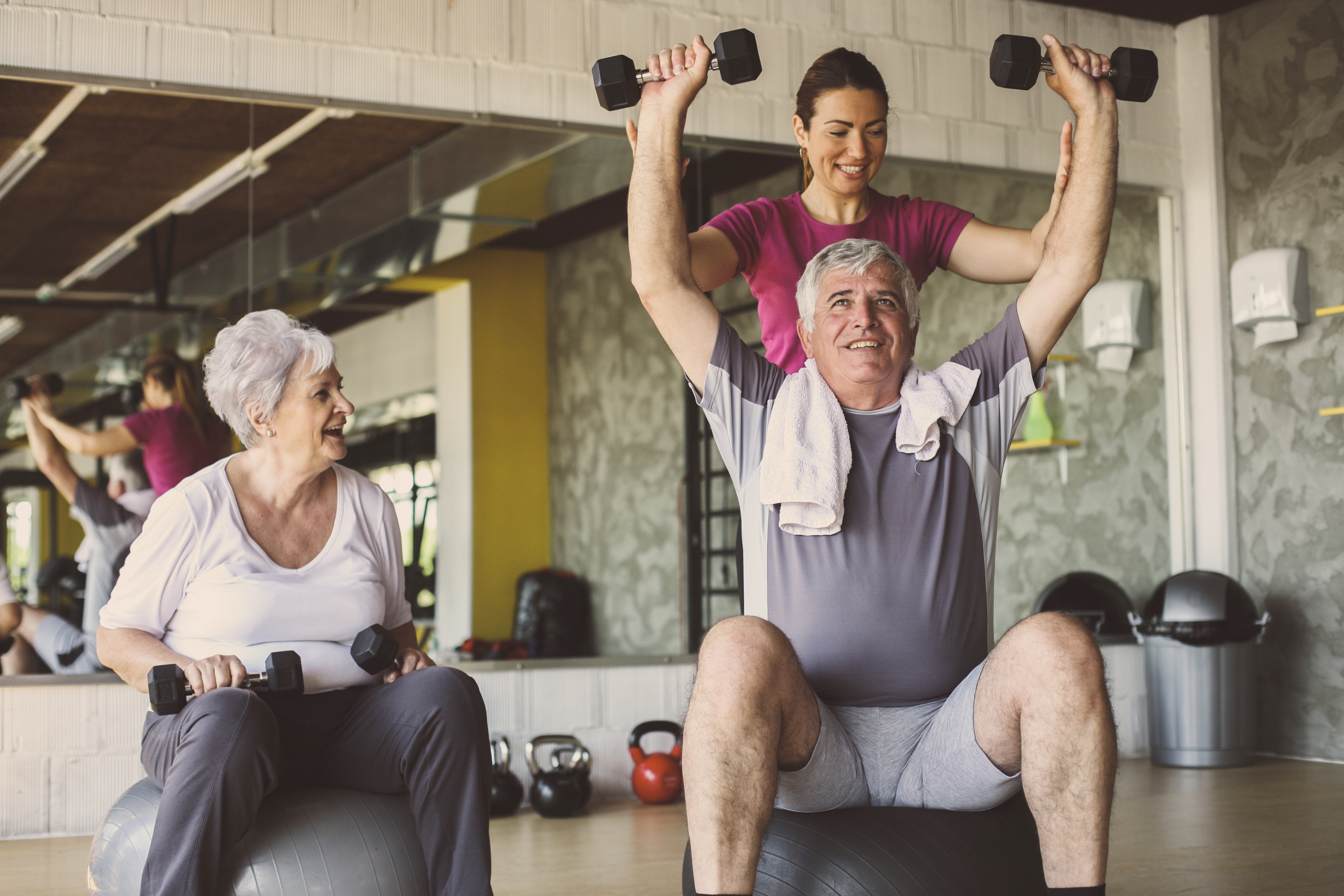The Importance Of Strength As We Age
Amy Bean
Thursday, June 9th, 2022
sarcopeniastrength trainingstrengthening
 Guest Blog written by Phoebe Cassedy, Musculoskeletal Physiotherapist and expert in strength and fitness in older adults.
Guest Blog written by Phoebe Cassedy, Musculoskeletal Physiotherapist and expert in strength and fitness in older adults.
Most of us know we should all be exercising regularly, probably more than most of us are! Some of us may even recall the recommended amount we should be doing: the UK Public Health Physical Activity Guidelines recommend that adults, and older adults are active daily, with either 150 minutes of moderate intensity activity, or 75 minutes of high or vigorous intensity activity (1). Moderate could be activities such as gardening, brisk walking, cycling (activities causing you to get a bit of short of breath but able to talk in full sentences). High or vigorous activities need to be more intense than this, including running or sports (enough to cause fast breathing and you shouldn’t be able to talk in full sentences). These are recommendations for all adults, including older adults and those living with chronic conditions.
An additional, often overlooked, part of the Physical Activity Guidelines is the recommendation for muscle strengthening or resistance exercise at least twice a week! This is again recommended for all adults, and is actually MORE important as we get older.
So what does muscle strengthening or resistance based exercise even mean? (the terms are usually interchangeable, so we will use both throughout!). And why is it so important? According to the American College of Sports Medicine muscle strengthening is “a form of physical activity designed to improve muscular fitness by exercising a muscle or muscle group against external resistance” (2). Essentially, activities which involve asking your muscles to perform or do some work against a form of resistance; this resistance could be your body weight, or an added external form of load.
This is actually something we are doing all of the time: think of every time we stand up from a chair, pick up and carry shopping, climb stairs. Strong and healthy muscles allow us to do these tasks. Importantly, into older age this allows us to stay independent with these tasks.
But the benefits of strength training are actually much greater than this! Strong and healthy muscles are essential for our cardiovascular health, metabolism, immunity, quality of life and, even, our longevity (3). Regular strength training is associated with a reduced risk of all-cause mortality (that is death of any cause!) (4).

In fact, a recent review found that compared to doing no resistance training at all, doing any amount of regular resistance training was associated with a 19% reduced risk of all cause mortality; a 19% reduced risk of cardiovascular disease mortality, and a 14% reduced risk of cancer mortality! (5). So yes, we need muscles to physically do things, but we also need them to survive!
Unfortunately age works against us in many ways, including our muscles! As we age, we naturally lose muscle mass, strength and power, as well as bone density. Most of us reach peak physical capacity between the ages of 20-30 years old. After which our muscle mass and strength start gradually declining. From about the age of 50, the decline is rapid: with reported 1-2% of muscle mass loss per year, and 1.5-5% of muscle strength loss per year (6).
This huge loss of muscle mass and strength can have stark consequences into our older age; the clinical term used to describe this progressive loss is sarcopenia; which is associated with increased physical disability, falls, frailty, negative health outcomes, higher healthcare costs, need for long term care and an increased risk of death (7).
This may all sound doom and gloom, but these changes are not all inevitable! There are of course some inevitable physiological processes leading to reductions in muscle mass and strength as we get older, but the changes are also hugely influenced by how much activity we do and how much we use our muscles (8). We must be using and challenging our muscles regularly to keep them healthy.
Regular strength training has been shown time and time again to reduce and even reverse this loss of muscle mass and strength, with associated improvements in physical performance (9, 10). Additional positive effects of regular resistance training include increased cardiovascular benefits compared to aerobic exercise alone (11); increased bone density (12); more effective weight loss than aerobic exercise alone (13); positive effects on sleep, anxiety, self-esteem and depression (14). The benefits are quite literally HUGE, and strength training really doesn’t have to be complicated!
There are so many activities you could use to strengthen your muscles. It doesn’t have to be using scary weights in the gym (although there is no reason that should be scary!). All you need is a method of applying additional resistance or load to challenge them. And importantly, you need to keep challenging them regularly!
For beginners, bodyweight exercises are perfect for learning key movements and getting your muscles working. For example standing from a chair, stepping up a step, doing a push up against a wall. Household objects are a great way to think about adding some extra resistance or load i.e. water bottles, books, cans in plastic bags; you could use these as weights to push above your head, perform a rowing type movement, or even hold them in your hands when you are doing your sit to stand, squat or step up.
If you want to get more advanced you need to think about ways of adding heavier load or weight. Buying weights for home, or joining a gym are both great options. It is essential we keep challenging our muscles, because our muscles do adapt to the load we are regularly putting upon them. Options could be adding a bit more weight, performing the exercise slower, or adding in pauses, for example. This is known as progressive overload. Equipment options for added weight include dumbbells, kettlebells, resistance machines or barbells. Gyms are perfect for getting access to this type of equipment, but more and more people are getting a good gym set up at home which works perfectly.

If you are really not sure where to start, we can use the key recommendations from the American College of Sports Medicine as guidance for starting strength training:
- Body weight, free weights, machines or bands can be used for resistance
- Perform multi-joint exercises working the major muscle groups (this means putting more focus on exercises that work multiple muscle groups including a squat or a press up, rather than an isolated bicep curl for example)
- Recommended 2-3 sessions per week
- Recommended 8-10 exercises per session (this is a general guideline, it can change depending on the challenge or intensity of each exercise)
- Perform 8-12 repetitions of each exercise, for 2-3 sets (meaning you perform 8-12 repetitions, then have a rest, then repeat this 2-3 times)
- Exercises should be performed with control and relatively slowly (aim for 2 seconds up and 2 seconds down for most exercises)
- A rough guideline of 8/10 difficulty per exercise is recommended (0 meaning no effort at all, 10 meaning the hardest effort you could give). If you find an exercise or weight getting easier over time, this should be progressed either by adding more weight on, performing the exercise slower, or adding in a pause for example. (15)
These are helpful principles to help you get started. If you take any one message from this blog, hopefully it is that strength training is for everybody, it shouldn’t be scary, it has HUGE benefits and it is increasingly important as we age!
About me:
My name is Phoebe Cassedy, I am a musculoskeletal physiotherapist, and I run the Keeping Strong website.
I have a keen interest in promoting strength training for older adults. On our Keeping Strong website we have a number of blog posts, resources, and free beginner and intermediate strength training programmes to help people get started.
Useful resources for further reading:
NHS guidance on strength exercises
Stronger My Way – New campaign from the Chartered Society of Physiotherapists with tips on getting started with strength training
References:
- https://www.gov.uk/government/collections/physical-activity-guidelines
- https://www.prescriptiontogetactive.com/static/pdfs/resistance-training-ACSM.pdf
- https://pubmed.ncbi.nlm.nih.gov/22777332/
- https://pubmed.ncbi.nlm.nih.gov/31104484/
- https://pubmed.ncbi.nlm.nih.gov/35599175/
- https://www.ncbi.nlm.nih.gov/pmc/articles/PMC3940510/
- https://www.ncbi.nlm.nih.gov/pmc/articles/PMC4269139/
- https://pubmed.ncbi.nlm.nih.gov/26980367/
- https://www.ncbi.nlm.nih.gov/pmc/articles/PMC4324332/
- https://pubmed.ncbi.nlm.nih.gov/29521871/
- https://pubmed.ncbi.nlm.nih.gov/30615666/
- https://www.hindawi.com/journals/bmri/2018/4840531/
- https://pubmed.ncbi.nlm.nih.gov/29086504/
- https://journals.sagepub.com/doi/abs/10.1177/1559827610368771
- https://www.acsm.org/docs/default-source/files-for-resource-library/resistance-training-for-health.pdf?sfvrsn=d2441c0_2